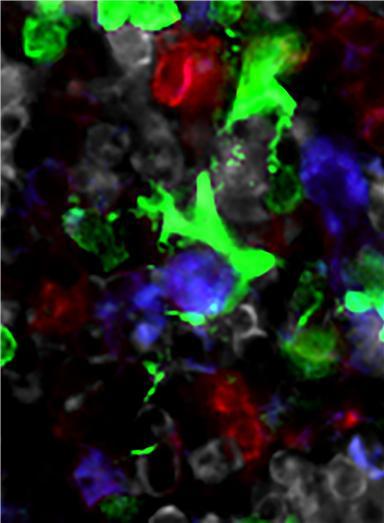The 'Signal Cell' relaying microbiota signals discovered

CX3CR1+ mononuclear cells (colored in green) are contacting hematopoietic progenitors (colored in purple) in the bone marrow. When CX3CR1+ mononuclear cells recognize the microbiota signals, they produce inflammatory cytokines which expedite the hematopoiesis. Credit: POHANG UNIVERSITY OF SCIENCE & TECHNOLOGY (POSTECH)
Professor Seung-Woo Lee, Research Professor Yunji Park, Master/PhD integrated program students, Seungwon Lee and Hyekang Kim of Division of Integrative Biosciences and Biotechnology from POSTECH described the mechanism how microbiota signals are sent to different organs.
Also, they utilized imaging research to prove that CX3CR+ mononuclear cells contact hematopoietic progenitors for the first time in history. Their research is introduced as a featured content in the journal of the American Society of Hematology, Blood.
Recent researches on microorganism concluded that microbiota control biological phenomenon not only in digestive tracts but also in lung, liver, brain, bone marrow and other organs. But, none of them were able to define a mechanism for relaying microbiota signals to entire body or for producing immune cells by receiving microbiota signals.
Professor Lee and his research team focused on the fact that the microbiota regulate the immune system of our body by controlling hematopoiesis in the bone marrow to produce white blood cells. In this process, the team discovered that the microbiota signal including bacterial DNA is transferred to the bone marrow through bloodstream and CX3CR1+ mononuclear cells in the bone marrow recognize this signal.
They explained that when CX3CR1+ mononuclear cells recognize microbiota signals, they release signal substances called cytokines which control and stimulate body's defense system through the signal transduction. They also explained that cytokines control the number of hematopoietic progenitors or stimulate differentiation into myeloid lineages to make blood cells.
Furthermore, they verified that CX3CR1+ mononuclear cells contact hematopoietic progenitors at the perivascular region and they play as a signal receiving microbiota signals.
They discovered the hematopoiesis control mechanism which is controlled by cytokines produced when CX3CR1+ mononuclear cells recognize microbiota signals transferred to the bone marrow.
Professor Seung-Woo Lee commented, “For the first time, our research describes the mechanism that had not been explained how microbiota regulate not only digestive tracts but also entire body response. It might be possible to apply this study to control immune response in other parts of a body or to treat cancer and inflammatory disease via microbiota signal pathway.
This study was financially supported by National Research Foundation of Korea, Regional Leading Research Center, and Korea Ministry of Science and ICT under BK21 Plus project.
Media Contact
Jinyoung Huh
jyhuh@postech.ac.kr
82-542-792-415
Media Contact
All latest news from the category: Life Sciences and Chemistry
Articles and reports from the Life Sciences and chemistry area deal with applied and basic research into modern biology, chemistry and human medicine.
Valuable information can be found on a range of life sciences fields including bacteriology, biochemistry, bionics, bioinformatics, biophysics, biotechnology, genetics, geobotany, human biology, marine biology, microbiology, molecular biology, cellular biology, zoology, bioinorganic chemistry, microchemistry and environmental chemistry.
Newest articles

NASA: Mystery of life’s handedness deepens
The mystery of why life uses molecules with specific orientations has deepened with a NASA-funded discovery that RNA — a key molecule thought to have potentially held the instructions for…

What are the effects of historic lithium mining on water quality?
Study reveals low levels of common contaminants but high levels of other elements in waters associated with an abandoned lithium mine. Lithium ore and mining waste from a historic lithium…

Quantum-inspired design boosts efficiency of heat-to-electricity conversion
Rice engineers take unconventional route to improving thermophotovoltaic systems. Researchers at Rice University have found a new way to improve a key element of thermophotovoltaic (TPV) systems, which convert heat…



